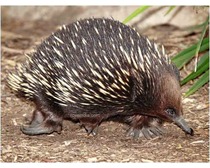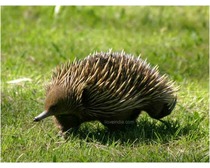The most amazing fact about echidna is that despite being a mammal, it lays egg. Read on to know about some more interesting facts and amazing information on echidnas.
Facts About Echidna
Echidna, also known as the spiny anteater, is a type of primitive mammal that inhabits Australia and New Guinea. It belongs to the group of monotremes, which consist of the egg-laying mammals. The only mammal that lays eggs, other than echidna, is platypus. Echidna is a small mammal that has its body, covered throughout with coarse hair and spines. It looks like the anteater of South America and also like other some other spiny animals, like porcupines and hedgehogs. However, it belongs to a completely different family. Echidna is classified into two species, namely, Tachyglossus aculeatus (short-beaked echidna) and Zaglossus bruijni (long-beaked echidna). Usually, echidnas feed on ants and termites, but sometimes they may also eat beetles, scarab and moth larvae, and worms. Echidnas like to live in isolation, except during the mating time and while females raise their young. We bring you some more interesting facts and amazing information on echidna in the below lines. 

Fast Facts
Kingdom: Animalia
Phylum: Chordata
Class: Mammalia
Order: Monotremata
Family: Tachyglossidae
Length: 36-99 cm long with a 10 cm long tail
Weight: 2 to 7 kg
Life Span: 50 years in captivity
Diet: Ants, termites and insects
Call: Sniffing noise
Habitat: Rocks, caves, bushes and almost anywhere in Australia
Mating Time: July and August
Hatching Period of Eggs: 10 days
Number of Egg: One
Interesting & Amazing Information On Echidnas
- The female lays egg twenty-two days after mating and puts it into her pouch. The egg is soft-shelled and leathery in nature.
- A young echidna is called puggle. It is born blind and hairless. Echidna has no nipples, so the puggle sucks milk from the pores of two milk patches.
- A puggle remains in the pouch of the mother for about 45 days, during which it starts to develop spines. Consequently, it leaves its mother’s pouch.
- The mother echidna digs a burrow to keep the puggle and in the course of five days, it returns to feed the baby, till it is weaned at seven months.
- Male echidnas have a penis with four heads; however they use only two heads while mating, while the other two heads do not grow in size.
- Echidna goes for REM sleep when the surrounding temperature is around 25°C. However, the tendency of REM gets suppressed at 15°C and 28°C.
- The snout of an echidna serves as both the nose and the mouth. The animal has a slender and elongated snout.
- The animal is a strong digger and uses its short and strong limbs, with large claws, for the purpose. It is also capable of swimming.
- It finds out food, like ants and termites, by smelling it and subsequently uses its claws to dig it out.
- An echidna has a small mouth and toothless jaw. It has a long, sticky tongue, which protrudes out from its snout. Its tongue helps in collecting its prey. Since it does not have teeth, it crushes the prey between the horny pads present in its mouth.
- The short-beaked echidna feeds on ants and termites, whereas the Zaglossus species’ main food comprises of worms and insect larvae.
- The animal has distinct defensive mechanism. On being threatened by a danger, it either runs away, using its short and stubby legs or curls itself in the shape of a ball, with only the spines exposed.
- The tongue of an echidna can be six inches long.
- Zaglossus bruijni or the long-beaked echidna is an endangered species.
- The name echidna was derived from the name of monster in Greek mythology.
- An echidna’s milk is pink in color due to the high iron content.
- It is believed that the ancestors of echidnas existed at the time of the dinosaurs. Although dinosaurs perished, echidnas lived.
- Echidnas remain active both during the day and night.
- Echidnas can live up to 45-50 years.
- These mammals can lift objects twice their weight.
- An echidna is slightly less intelligent than a cat.
- Echidnas have evolved from aquatic ancestors, who later resumed to living on land completely.
- Due to their ancestral association with water, echidnas are excellent swimmers!
- Like the male platypus, male echidnas have spurs which are non-venomous.


See also
More from iloveindia.com
- Home Remedies | Ayurveda | Vastu | Yoga | Feng Shui | Tattoos | Fitness | Garden | Nutrition | Parenting | Bikes | Cars | Baby Care | Indian Weddings | Festivals | Party ideas | Horoscope 2015 | Pets | Finance | Figures of Speech | Hotels in India : Delhi | Hyderabad | Chennai | Mumbai | Kolkata | Bangalore | Ahmedabad | Jaipur
- Contact Us Careers Disclaimer Privacy Policy Advertise With Us Lifestyle Sitemap Copyright iloveindia.com. All Rights Reserved.




